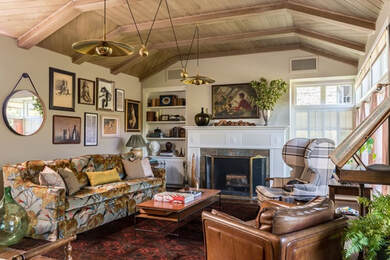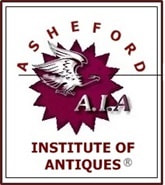 Patterns & Prints Return Patterns & Prints Return New York - For many antique and vintage dealers it can be easy to lose sight of the proverbial what's-popular "ball" sometimes, especially when it's tossed across the field so frequently with little advance notice. While online behemoths like Etsy, eBay, and Wayfair are often considered the barometer for what's trending and popular in the marketplace at any given time, there are many industry insiders who actually take a contrarian view, believing that the Internet giants are more of a market laggard than they are a predictor when it comes to deciphering the current direction of decorative arts trends.  Wingbacks Gain Favor Wingbacks Gain Favor For Tamara Holt, an interior designer and fine-arts dealer from Paris, who works both sides of the Atlantic, figuring out up-and-coming trends is more about who you're listening to, than what. Holt credits much of her business success as a dealer for having an open ear to younger collectors, who may not have the money for lavish purchases, but are often on-point when it comes to burgeoning marketplace moves. "Last year while attending local antique markets, I noticed that 20-somethings were beginning to take an interest in period pieces, like wingback chairs, rolled-arm sofas, and French country-style dining tables that had a little history attached to them. I even saw some velvet pieces moving," said Holt. According to her bio and business blog, much of what she puts in her storefront tends to be transitionary. "If I see changes happening within the collectible landscape, I'll also try to incorporate and reflect that change into my interior design motifs for the upcoming year," she said. Holt noted that many of her clients in New York also appeared to be retreating from the overly modernized design base that's been so prevalent for so long in the decorative arts community, and have instead begun moving back to more established styles of decorating. "I'm getting lots of requests for natural wood antiques, stone-topped pieces, and even pattern textiles and linens," says Holt, "All of which is a huge departure from what I've been seeing over the last eighteen-months."  Softer Hues & Natural Wood Softer Hues & Natural Wood Of course, picking-up on the latest decorative arts trends can come from a variety of sources - including those whose job consists of recognizing such trends as they're just beginning to happen. Design Diva, Roxy Owens of Society Social, says that it's time to say goodbye to monochromatic neutrals and minimalist design features and welcome back more traditional themes of decorating. “Now more than ever we are seeing a return to cozy and warm interiors. Think beautifully layered spaces, a mix of prints, patterns, and colors, delicious wallpapers, textures, pleated and patterned lampshades as well as bespoke textiles.” While some are calling this trend the Minimalist-revolt, and the first true break from the Mid-century modern movement, others are simply referring to it as the rise of Maximalism. Whatever you choose to name it, the general consensus from many design professionals is that the return of warm wood tones in the form of antique furniture, and those elements associated with it, appear to have finally arrived back on the decorative arts scene after a rather lengthy sabbatical. Printed sofas, wall papers, leather chairs and even plaid and floral prints on upholstered antique and vintage chairs are all making a dramatic comeback.  70's Modular & Recycling Are In 70's Modular & Recycling Are In While some industry experts agree with the notion that 2022 may possibly be the first year of a noticeable retreat in minimalism and Mid-century modern influences, there's full agreement amongst most designers that vintage furniture and 'going-green' will continue to be one of the most popular decorative arts trends for the foreseeable future. Tracy Shea, who operates a number of vintage themed booths along the west coast, and a storefront operation in San Francisco, says that young people are making 'environmentally' based decorating choices, and that it's changing the way she does business. "They want something sustainable," says Shea, "things that will last a lifetime and not contribute to the landfills." It doesn't have to just be antique furniture though she says, "As long as it's good quality and something that will last, it's selling." Shea also notes that supply-chain issues for more traditional furniture stores might be having a net-positive effect on her business, "If you can't get a cheap chest-of-drawers because it's sitting on a boat somewhere, I'm probably going to benefit from that," she says. Solid wood tables, bookcases, glass-topped pieces from the 1960s, and heavy molded and modular pieces from the 1970s are all in high demand. "It's really all about timing," she says, "Vintage and the Boho look (Bohemian inspired design) are all in, and I just happen to have access to that type of inventory." Tom Wheeler who specializes in outdoor wrought iron and vintage furniture, along a coastal tourist route just east of Toronto on Lake Ontario, says that he noticed a small drop in interest last year related to modern-metal themed pieces, and an uptick in requests for rattan, wicker, and old wrought iron items towards the end of the summer. "I don't know if it's a move away from mid-century themes," says Wheeler, "but there's definitely been more requests for traditional types of garden and outdoor furniture like I used to sell." Wheeler who's been in business for almost half-a-century says that based on his experience over the last fifty years, he thinks we're probably due for a change. "I've sold more 50's style metal tulip chairs than I care to remember," says Wheeler, "I think I'll just be happy to see something different come along." Predicting and caressing the crystal ball always comes with risks, but for many dealers and collectors the writing on the wall has apparently become far more clear recently as a sizable consensus appears to be building for a move away from the modern design sensibility, and a return towards the softer lines of more organic shapes and earth-toned hues. Whether or not this growing interest in all things antique and vintage can truly and fully supplant the current retro-modern decorative arts theme remains to be seen, but with so many marketplace-experts and industry-insiders currently on board, now might not be the best time to bet against the house. - A.I.A. Staff Writers  NOTE: For readers seeking more information about the Asheford Institute Of Antiques distance-learning program on professional-level appraising, the study of antiques, collectibles, vintage and mid-century modern items, please click here to visit the school's Home Page. Should you have additional questions about the Asheford program, you can also write to the school at: [email protected] or call the Registrar's Office toll-free at: 1-877-444-4508. |
AIA StaffWe're providing our students and reader's with the latest breaking news on events and happenings that we think might be of interest to both collectors and dealers alike. Including changes within the world of antiques, vintage, collectibles and appraising that might just have an effect on your bottom line. We're also interested in hearing from you - so if you've got a great newsworthy story, let us know, and you just might find it here! Archives
July 2024
CategoriesLegal Disclaimer: Extraneous opinions, statements and comments made by individuals represented within these posts do not necessarily reflect those of the Institute. The publication naming of specific business entities, organizations, and concerns, contained herein, in no way represents an endorsement or recommendation of services or products by the Institute. Publicly identifiable information contained herein (including, but not limited to contact information), has been intentionally limited where possible, due to privacy and legal concerns related to the digital dissemination of information through online means. All views expressed herein are those of their respective owners. The Institute is in no way responsible, financially or otherwise, for the accuracy or validity of statements contained within published posts from sources that originate and appear outside of the written and expressed views of those submitted by the Institute.
|


 RSS Feed
RSS Feed




